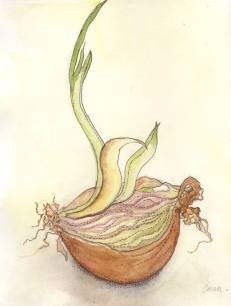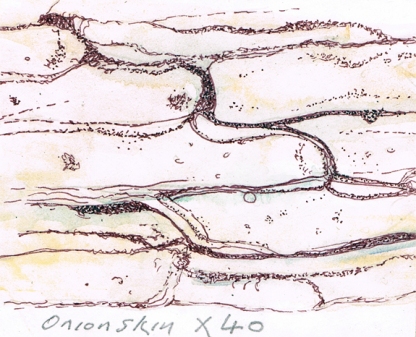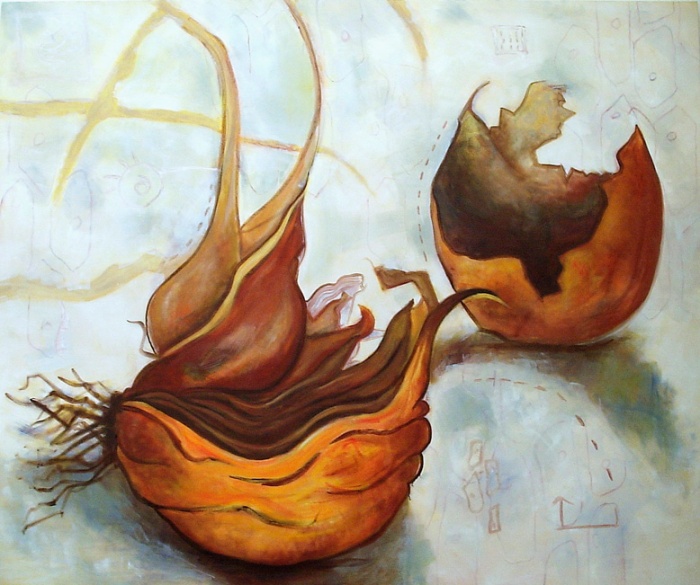So 2005 I finished the painting commission, discovered nematode worms, and realised that the everyday world really was full of weird and amazing things. One day, on a clean out of my kitchen cupboard (disgustingly dirty) I discovered half an onion that had started sprouting a shoot. It was beautiful so I kept it and wrote this short diary about it:
28th March 2005
Half an onion was discovered at the very back of the kitchen cupboard amongst a quantity of crumbs of indeterminate origin and a dried up carrot. It’s outer skin has started to rot, but from its centre emerges a large white horn, bareing a striking resembalance to what may be described as a minature Rhino’s horn, only far whiter. I took it out of the cupboard and placed it on the window sill.
14th April 2005
The horn has grown so quickly it is four times larger now than it was when I found it (in fact it grew from 3.3cm to 14.1cm approx), and it’s tip has turned green. I did think that I should sit down in front of it and watch it for a whole day, but grew bored with that and gave up. Instead I looked up some health facts about onions on the internet (I’m feeling rather cold ridden today).
Health facts about onions that I was oblivious to before my onion discovery:
‘They appear to be at least somewhat effective against colds, heart disease, diabetes, and other diseases and contain antiinflammatory, anticholesterol, and anticancer components.
In many parts of the underdeveloped world, onions are used to heal blisters and boils. In the United States, products that contain onion extract (such as “Mederma”) are used in the treatment of topical scars.’ Wikipedia
18th April 2005
It has now started growing another horn like shoot, plus the first horn has developed two offshoots. I’ve given it a bit of water, though not being watered at all didn’t seem to bother it. I guess it gets nourishment from what remains of the onion. I decided to paint a picture of it.

- Watercolour and pen sketch of the onion sitting on the kitchen window sill.
21st April 2005
Although the abandoned state seen above is clearly aesthetically pleasing (the curved onion base tilting slightly forwards to balance the horn, giving a sense of strain and desperation that can only be felt by the liberated onlooker) I’ve decided to plant the onion in a small brown ceramic bowl with a little mud. I felt that in order to fully explore the onion growing process I needed to encourage growth and that the best way to do this might be to plant it.
29th April 2005
The onion has continued to grow, I give it a single drop of water every day. I have decided to explore the biological constituency of the onion further. I dig part of it up and peel off a tiny bit of inner skin. From this I peel off a transparent film which I put on a slide and dye with a drop of iodine, I then put the slide under the microscope.

This activity is one of the first uses of an optical microscope that most students encounter in a biology lab. Onions are used because they have large cells that are easily visible under a microscope and the preparation of a thin section is very straight forward..An onion is made of many concentric layers. Each layer is separated by a thin skin or membrane.
30 May 2005
The half an onion grew rapidly for a bit but now appears to be dying. I did it up out of its ceramic bowl and place it on the window sill. It has a different type of beauty now, full of rich purples, deep reds, and the withering of its stems has a dramatic appeal.

- Evidence, 12ft by 8ft Oil painting on Canvas. This very large painting was done from a sketch of the dying onion. I won Challenge the Nail art prize that year and had my first solo London show. I painted this picture for that. Why so large I don’t know, perhaps I was paying my respects to the onion somehow, or appeasing the god of onions.




